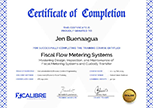| Date | Format | Fee | |
|---|---|---|---|
| 01 Sep - 05 Sep 2025 | Virtual/Live | $ 2,950 | Register Now |
| 08 Dec - 12 Dec 2025 | Virtual/Live | $ 2,950 | Register Now |
| 31 Aug - 04 Sep 2026 | Virtual/Live | $ 3,450 | Register Now |
| 07 Dec - 11 Dec 2026 | Virtual/Live | $ 3,450 | Register Now |
About the Course
Hazardous wastes may be found in different physical states such as gaseous, liquids, or solids. A hazardous waste is a special type of waste because it cannot be disposed of by common means like other by-products of our everyday lives. Depending on the physical state of the waste, treatment and solidification processes might be required.
The international community has defined the responsible management of hazardous waste and chemicals as an important part of developing a sustainable economy, with sustainable development in mind we measure two indicators to "achieve the environmentally sound management of chemicals and all wastes throughout their life cycle".
Improper storage of hazardous chemicals - both products and wastes – incompatible inspection of containment materials, using hazardous products when non-hazardous products are available, and inadequate staff training are some of the leading causes of environmental contamination. The contamination can come in many forms- Some examples of contamination are ground and surface water, land, air, radioactive, food, noise, moulds, odour, construction, vibration, etc. and invariably, if these contaminants are not adequately dealt with, they will result in pollution and certain situations serious health problems.
This 5 – day interactive Hazardous Waste Management & Pollution Control virtual training course will give details on the various types of contaminants and the new frontiers in eliminating or minimising these contaminants, the use of effective non-hazardous products in the company and also environmentally acceptable methods of disposal for both hazardous and non-hazardous wastes.
Core Objectives
By learning this virtual training course, the delegates will understand and be familiar with:
- Learn about the various types of contamination and which ones are more applicable to your company
- Encourage and facilitate dialogue with like-minded individuals on specific contamination issues of concern in the organisations and the opportunity to develop regional networks
- Learn about the relevant environmental treaties dealing with contamination and pollution
- Learn how to prioritise contamination problems in dealing with contamination and waste management issues in a logical sequence
- Show and emphasize the close relationship between human health and the environment that’s been directly affected by contamination
- Current methodologies for the clean-up of contaminated soil, ground, and surface water, air pollution, construction materials and radioactive materials
Training Approach
This training course is a mixture of lecture, video presentation, trainer-facilitated workshop exercises, and case study analysis organised through a Virtual Learning Platform anytime and anywhere.
The Attendees
This Hazardous Waste Management and Pollution Control virtual training course is for anyone interested in hazardous waste but will be of particular interest to policymakers, designers, and businesses looking for inspiration on the management and control of waste and pollution.
This virtual training course is suitable to a wide range of professionals but will greatly benefit:
- Health, Safety and Environmental Professionals
- Hazardous Wastes Management Staff
- Staff Responsible for Contamination Issues
- Laboratory Technicians
- Technical Assistants
- Emergency Personnel
- Staff wishing to reduce risk and liability arising from polluting events
Daily Discussion
DAY ONE: OVERVIEW OF CONTAMINATION AND HAZARDOUS WASTES
- What is contamination, and how does it affect us?
- Various types of contamination
- Global Environmental issues related to contamination
- International Environmental Treaties and Guidelines related to Contamination
- The toxic 12 Chemicals and the role of the United Nations Environment Program (UNEP)
- Watch list for chemicals that soon may be added to the toxic 12
- Environmental Law and its Significance
- Definition of Hazardous Wastes & Non - Hazardous Wastes
- Connecting the dots between Contamination and Hazardous Wastes
DAY TWO: MANAGEMENT OF CONTAMINATION AND HAZARDOUS WASTES
- The relationship between Contamination and Occupational Health & Safety
- Importance of documentation in Hazardous Waste Management
- Typical Hazardous Waste Regulations and the need for harmonization
- The purpose of a Workplace Hazardous Materials Information System (WHMIS)
- The purpose of a Material Safety Data Sheet (MSDS)
- Why is a Globally Harmonized System (GHS) is essential for WHMIS and MSDS?
- Carrying out a Contamination Audit
- Managing a Waste Disposal Site
DAY THREE: CONTAMINATION AND POLLUTION PREVENTION
- Exploration & Production: Refining & Transportation
- Modern Tanker Design: Minimising the occurrence of a major oil spill
- Other oil-related sources of pollution
- The common thread amongst many third world countries concerning pollution issues
- The current concepts of Zero Waste (ZW) and Zero Liquid Discharge (ZLD) and their limitations
- The Bird Problem: Pollution from bird droppings and dead birds and the latest available technologies to control this problem
DAY FOUR: PLANNING AND CONTINGENCY PLANNING FOR MAJOR INCIDENTS
- Life Cycle Management: The materials used in an organisation
- The 5R’s: Reduce, Reuse, Recycle, Recover, and Rethink
- Requirements for proper storage of hazardous materials
- The importance of regular reviews of emergency plans
- Updated information on ISO 14001, 45001, and 9001
- Types of Environmental Audits
- Major Preventable Accidents
DAY FIVE: BIG PICTURE OF THE MANAGEMENT AND PREVENTION OF CONTAMINATION AND HAZARDOUS WASTES
- HAZID (Hazard Identification)
- HAZWOPER (Hazardous Waste Operations)
- Environmental Ethics
- Climate Change Updates and its Significance
- Greening the Company at a reasonable cost
Certificate Awarded
Upon successful completion of this training course, participants will be awarded a Certificate of Completion from XCalibre Training Centre, acknowledging their accomplishment. This certificate serves as a testament to their dedication to developing their skills and advancing their expertise in their respective fields.


